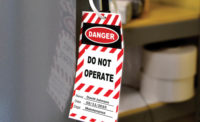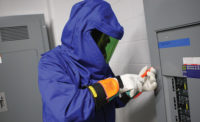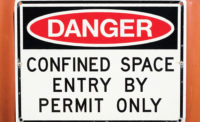Other than high voltage shock, an arc flash and blast event is one of the most horrific electrical accidents a person can experience. When an arc flash occurs, temperatures in arc plasma can reach up to 10,000˚F. In addition, there is the accompanying pressure wave, intense light and sound, flying molten metal, and shrapnel.
An arc flash is a high-amp current that jumps through the air. It occurs when the path of the electric current is interrupted, causing the current to flow through the air to a new conductor or to ground, causing a very bright flash of light.
Accompanying the arc flash is the arc blast, which is a rapid burst or explosion of super-heated gas, droplets of molten metal, or shrapnel, that explode outward at more than 700 mph. When contained this pressure wave can cause contusions and knock a worker down.
No one is certain exactly how frequently these incidents occur, but some sources estimate there are five to ten electrical equipment explosions each day in the United States.
Causes of arc flash accidents
Arc flash may occur when employees work on energized electrical equipment, instead of de-energizing it first.
One of the underlying causes of these accidents is when an employee touches a live electrical component (such as a busbar, wire, etc.) most often with a conductive tool (screwdriver, pliers, etc.). Other incidents involve the removal of an electrical panel door, which then makes contact with exposed energized components or dropping of screws or bolts in the removal process.
Sometimes the electrical components are not installed properly and can move or shift position, causing a short when they come into contact with other components. And there have been cases where water got inside an electrical panel and caused an arc flash, resulting in burns to employees working nearby.
Protecting employees
Employers must take precautions to protect personnel from arc flash hazards. As mentioned, the best option is to always de-energize electrical equipment before working on it. However, sometimes de-energizing electrical equipment can result in an arc flash hazard.
Here are some things you can do to protect your employees from arc flash and blast:
- De-energize electrical systems before starting
- the job.
- Maintain protective equipment in a safe, reliable condition.
- Periodically inspect protective equipment.
- Provide flame-resistant clothing when required (OSHA 1910.269 and 1926 Subpart V) in the construction and repair of electric power generation, transmission and distribution.
- Protect the insulating material if it can be subject to damage during use.
- Require employees to wear nonconductive head protection whenever there is the danger of head injury from electric shock or burns due to contact with exposed energized parts.
- Require employees to wear protective equipment for the eyes or face wherever there is danger of injury to the eyes or face from electric arcs or flashes or from flying objects resulting from an electrical explosion.
- Require employees to use insulated tools or handling equipment if the tools or handling equipment might make contact with exposed energized conductors or circuit parts.
- Require that fuse handling equipment, insulated for the circuit voltage, is used to remove or install fuses when the fuse terminals are energized.
- Guard normally enclosed live parts that are exposed for maintenance or repair.
Is an arc flash assessment required?
An arc flash assessment helps detect if arc flash hazards are present at a facility, evaluate if there is the possibility of injury to employees and how severe that injury would be, and determine what protective processes are needed (including personal protective equipment).
NFPA 70E Standard for Electrical Safety in the Workplace has (since 2000) included information on performing an arc flash risk assessment. Federal OSHA doesn’t specifically require employers to perform an arc flash engineering study, as OSHA hasn’t adopted or required compliance with NFPA 70E. Paragraph (l)(8)(i) of § 1910.269 requires the employer to assess the workplace to identify employees exposed to hazards from flames or from electric arcs.
OSHA does recognize the importance of electrical safety requirements that extend beyond its own standards. The following is OSHA’s position on NFPA 70E from a Letter of Interpretation dated November 18, 2006:
“Because OSHA has not adopted through rulemaking the requirements of a more recent edition of NFPA 70E, those requirements have not become OSHA standards. A national consensus standard, however, can sometimes be relevant to a general duty clause citation in the sense that the consensus standard may be used as evidence of hazard recognition and the availability of feasible means of abatement. The general duty clause, Section 5(a)(1) of the OSH Act, is violated if an employer has failed to furnish a workplace that is free from recognized hazards causing or likely to cause death or serious physical harm. The general duty clause is used where there is no standard that applies to the particular hazards involved.”
OSHA is making it clear that just because they don’t have a specific requirement for performing an arc flash assessment, they will cite employers who do not make full use of commonly known information to protect workers.
Standards that provide guidance
The following standards provide guidance for reducing the risk of arc flash accidents in general industry in the United States:
- OSHA 29 CFR 1910 Subpart S—Electrical
- §1910.333 Selection and use of work practices
- §1910.334 Use of equipment
- §1910.335 Safeguards for personnel protection
- NFPA 70E Standard for Electrical Safety in the Workplace 2018 Edition
- NFPA 70 National Electrical Code 2017 Edition
- NFPA 2112 Standard on Flame-Resistant Garments for Protection of Industrial Personnel Against Flash Fire
- IEEE 1584-2011 (amended) Guide for Performing Arc Flash Hazard Calculations
Takeaways
Arc flash and blast accidents can cause fatalities and permanent injuries to employees. These injuries can be life-altering and result in long-term treatment. In addition, arc flash incidents can damage equipment and facilities and lead to lost production time and loss of business revenue.



